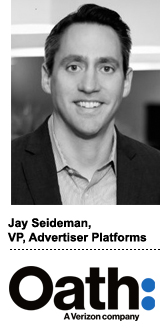
Jay Seideman will present on programmatic best practices at AdExchanger’s upcoming Programmatic IO New York conference on Oct. 15-16.
AT&T’s new advertising and analytics unit, Xandr, is capturing the headlines and Amazon is on its way to making the duopoly a trio – but don’t count out Oath.
The Verizon-owned digital media company is avidly angling for its piece of the digital media pie.
Oath debuted its unified ad stack, Oath Ad Platforms, at the beginning of September, creating a single entry point for $9 billion worth of tech, data and media inventory from AOL, Yahoo and Verizon. All of Oath’s demand will be available through the platform starting Sunday, Sept. 30.
The actual integration process only took about nine months, said Jay Seideman, Oath’s VP of advertiser platforms, a relatively quick turnaround if you think about how many different tech assets are coming together in a single stack.
Five months of tweaking and troubleshooting followed. But the platform is ready for prime time now – at least from a demand perspective. Oath is still consolidating its supply tools, with a planned 2019 launch – and the vision hasn’t changed since the beginning, Seideman said.
“It takes a lot of work to bring together a singular platform,” he said. “We always said that we have to get to a unified stack, and that is what we did – we’re at scale.”
The challenge for Oath now is boosting usage, Seideman said. Oath makes a three-pronged case to buyers that centers on unique data, proprietary inventory and performance.
“The DSP business is very sticky and although I see us in the top tier, we’ve only just rolled out our unified DSP compared with the more established players,” he said. “Migrations don’t happen overnight, so we have to give people a good enough reason.”
Oath is undeniably ambitious, but a question remains about how committed Verizon is to the original plan.
The announcement of Oath Ad Platforms was overshadowed by the impending departure of Oath CEO Tim Armstrong, perhaps in part because of Verizon’s reluctance to share mobile subscriber data.
But Seideman said the free flow of Verizon data to Oath was never part of the plan.
“Verizon has certain privacy constraints and we respect those,” Seideman said. “We leverage all of their data that we can safely leverage, but the reality is that Verizon has enterprise accounts, and we can’t touch those. I’d say we have some of the best seed data in the industry, though.”
And there’s more to Oath’s ad stack than just carrier data, he said, although Verizon’s contribution is a critical component. In addition to Verizon CRM data, Oath has Yahoo and AOL login data, device-level data from Flurry’s SDK, location data and content consumption data from Oath’s publisher brands.
“Some of the stories out there made it seem like that without Verizon data, we have no data,” Seideman said. “But part of our value prop is that we have segments made up from a variety of first-party data and other trusted data signals.”
This post was syndicated from Ad Exchanger.


More Stories
Stuff Group taps Belinda Francis to lead North Island Markets
Veteran Meteorologist James Spann Voices Support for NOAA and NWS in Anticipation of Trump Cuts
Inghams teams up with Together for groundbreaking media strategy